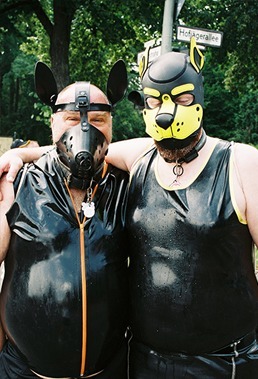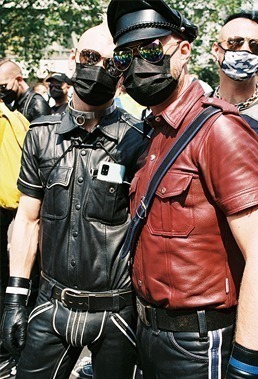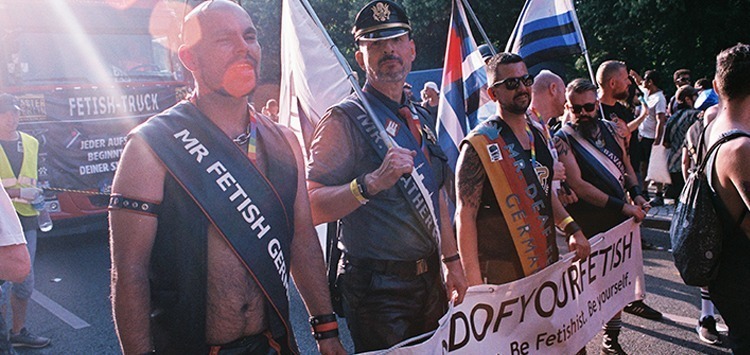And you're out - fetish at the CSD
The brambling
Do fetishists reinforce stereotypes about queer people? Our author observed a discussion about fetishists at a German CSD and wants to take a clear stance.
In the comments section of queer.de in summer 2019, there was a lively discussion about pet players, i.e. people whose erotic role play includes wearing animal costumes. The reason for the Reporting was an incident at the Aachen CSD: Despite the clearly clarified legal situation (wearing masks in this case does not violate the ban on masks), the Aachen police prohibited CSD participants from wearing dog masks and, according to an eyewitness, even threatened to stop the entire parade if necessary.
It is remarkable that the comments on queer.de only briefly centred on the scandalous unlawful actions of the police and very quickly turned into a discussion about the allegedly questionable visibility of the CSD participants concerned. Instead of the breach of law by the police, the presence of parts of the community at the CSD was declared a problem.
Unfortunately, this kind of desolidarisation is neither unusual nor surprising. Queer communities themselves - which may sound strange, but is actually no secret - have at least an ambivalent relationship to sexual diversity as soon as it goes beyond the usual formats.
Eeny meeny moo ...
I think it is short-sighted to see CSD parades solely as "advertising media" for the public, as they are also very important for internal community communication and culture. Nevertheless, CSD parades are undoubtedly the most important public representation of the various queer communities. It therefore makes sense to think from time to time about who and what exactly should be represented there - and what should not. The desire to see those groups to which one belongs represented in a highly visible way is always accompanied by the desire to deny certain other groups this very right to representation. Every year, at least one group is singled out for one reason or another and told that they are a nuisance, that they "don't belong at CSD" or that they should at least "keep a low profile" (which is just a way of saying "remain invisible"). Sometimes it's the queers or drag queens, then trans people, naked people, hedonists and so on. Always in turn and then all over again. People who make fetishes visible at CSD are also regularly targeted by this exclusion folklore, as is the case again right now.
One reason for criticism is the enormous attention gap that undeniably favours the so-called "birds of paradise" over the other participants: In the external perception, the vast majority of CSD participants often become almost invisible in their everyday clothes, in favour of the relatively few more sensationally dressed figures. The media also rarely reflect a truly differentiated picture of the parades [You are all shrill, shrill, shrill.]Instead, they focus very clearly on the spectacular and therefore more marketable images that drag queens and fetishists, for example, provide them with (although I have noticed a certain favouritism towards drag queens). One may rightly criticise these perception filters. At the same time, it must be soberly recognised that it is precisely these images that contribute significantly to the great success of the parades in terms of internal and public appeal.
However, I believe that a far more important reason for criticism is the urge to distance oneself from certain people or behaviours that one cannot tolerate being close to, especially in public.
Thoughtless reversal of guilt
The main argument is as follows: Allegedly, the fetishists visible at CSD are complicit in society's general queerophobia by reinforcing the stereotype that "all gays (rarely lesbians or trans people) are like this". What is meant here is, without saying it directly: "so perverted". They themselves supposedly have no problem with "these people", but the uptight, unenlightened straight people who are incapable of differentiation would certainly suddenly stop (or not even start) loving at least the "normal" homosexuals if they were to scare off these frightened little people with an overly cheeky, "provocative" appearance.
This is not a new idea [→ der zaunfink: There's no emancipation in Smurfville]. The most stigmatised subgroups should always show humble consideration for the clean men (or clean people, ignorance, unlike love, knows no gender) in our communities, so that the crawl path of those in the "middle of society" remains quite smooth. Result: At CSD, some people are allowed to come out of the closet and enjoy a freedom that they would otherwise not have. remains deniedthe others are summarily declared a "private matter" and unfortunately have to stay inside.
Act of debt cancellation
I don't devalue them, they drag me into the dark maelstrom of their negative image.
I think this argument is a pretence, at least in the case of fetishists. In the comments section on queer.de, you can currently recognise at least one thing more clearly than usual: Many opponents of petplayer visibility are at least honest enough to reveal their own resentments: Incomprehension, disgust and fear. However, as indicated above, their own emotions are usually concealed: their own unreflected resentment towards fetishists is projected onto society, where it is uncritically assumed and confirmed as an almost natural defence reaction. The devaluation of the fetish and its bearers is not questioned. One's own aggression against other sexualities/identities, which is only clumsily concealed in this argument, is concealed in an act of guilt reversal by declaring oneself the victim of the fetishist: "It's not me who devalues them, but they drag me into the dark maelstrom of their negative image."
At a demonstration for sexual diversity and freedom, one might perhaps expect that precisely this negative image should be recognised as the problem to be solved and tackled in solidarity. Instead, people who are already suffering from social resentment are simply being thrown under the bus by their own community.
At this point, the question once again arises as to what extent emancipatory ideals are actually still internalised by the majority of CSD participants and organisers, or to what extent they are still capable of consensus. It is about the strategic positioning of the CSD itself. As far as the concrete actions of organisers are concerned, the spectrum ranges from organising teams that banish fetish groups to the very end of the parade year after year to the decision to explicitly invite people in fetish clothing to participate - a welcome decision, but one that acknowledges the fact that the desirability of fetish outfits is by no means taken for granted without explicit encouragement.
I will return to the fundamental question at the end and would first like to examine some of the levels on which fetish "irritates" and "provokes".
Gender irritations
Let's take a brief look at a classic fetish, the gay leather guy. When it comes to visually or metaphorically illustrating the diversity of our communities, he has been appearing in gay contexts and in the media for many years as part of an alleged pair of opposites: The leather guy and the drag queen. The two are often imagined as the extreme poles of a gender spectrum between "extremely feminine" and "extremely masculine" - almost as if they embodied "full woman and full man" in Hirschfeld's sense. This is nonsense, of course, as these supposed poles are both mostly embodied by cissexual men and therefore only cover a very limited spectrum here - if at all.
In the image of the classic leather guy, fetishes (leather, uniforms, boots, etc.) appear primarily as attributes of an exaggerated "masculinity". On the surface, this is not directly about the level of sexuality, but about a sexualised "doing gender", i.e. the performance of a gender role. At first glance, the leather guy simply utilises very traditional gender attributes. However, the exaggeration that characterises these attributes and their sometimes highly concentrated accumulation adds a moment of irritation that connects the Lederkerl with the drag queen: The over-fulfilment of typical gender role clichés elevates the production into the realm of obvious costume, the non-real, at times almost parodic. The apparent confirmation of heteronormative role attributes in this form of "male-male drag" becomes subversive by making its own artificiality visible. The outfit of the leather guy marks a non-everyday life. From this perspective, Lederkerl and Drag Queen are not at different poles of a scale, but both at the same end of a different scale from "gender-neutral" to "gender over-marked" or another from "authentic" to "staged".
Whether all leather guys are aware of this or even deliberately use it in this subversive way is certainly doubtful; my small bubble of acquaintances and I are probably not representative. The fact remains that fetish at this level triggers a gender irritation that does not appeal to all viewers and presumably (whether consciously or unconsciously) also triggers a desire to distance oneself.
Breaking through role models
If we take a look at who else is cavorting around alongside the leather guys, we can see that cross-dressing or mix-dressing is particularly visible in the groups of fetishists. The heteronormative role models are deliberately broken here. The irritation caused by cross-dressing alone is further increased by the fact that it is sometimes difficult to judge from the outside what the motivation for this is. Is the person with the beard shadow in the rubber skirt there perhaps non-binary? Is she a man in everyday life but a woman in erotic role play? Is "feminisation" the fetish? The usual assumptions about the supposed unambiguity and continuity of gender are called into question here by the realisation that gender can not only be an ordinary everyday reality, but also a part-time gender role or a staging within a sexual game.
The people mentioned at the beginning of this article go in a completely different direction: they have a fetish for completely casting off human roles and, for example, dressing up as Puppy or fringes - a profound disruption of common assumptions about the permissible or even conceivable spectrum of acceptable identities.
The political question now is whether we should uncritically accept the defence that such irritations can trigger and use it as an argument for demands for exclusion, or whether we should be prepared to use it as an opportunity to critically examine our own and society's devaluations and consider how more freedom can be made possible for everyone in this area too. Even those who are not interested in fetishes themselves could actually be happy if the legal and social freedom to wear fetishes were generally as great as possible. You don't have to want to use freedoms yourself to be in favour of their existence. Just as the mere visibility of gay, lesbian, trans, inter, non-binary and other queer people still irritates many people, but can be used as a strategy to promote greater self-evidence and liberalisation precisely because of this (and not despite it), this is also the case with fetishes. Irritation is not only the price of liberalisation, it is also a necessary method for its implementation.
Impudence
One of the main aspects of the rejection of visible fetishes is quite banal: It's about sexuality. And in a relatively concrete sense. Most other parade participants only subtly hint at sexuality at most. Even the eroticised performances of the drag queens usually hint at sexuality rather indirectly and in the context of regulated gestures. Visible fetishes, on the other hand, lay the topic of sexuality rather plainly on the table or on the street. Although sex in the narrower sense is not directly performed in front of everyone, there is also no minimising, coding or hiding the fact that this is about sexuality. For homosexuals who, despite their own experiences, are sexually Shame It's outrageous, of course, that people still consider homosexuality to be a good thing: they've been trying for decades to finally lie the sexuality out of homosexuality, and then some guys in dog masks come along and put the stick that they thought they had so successfully thrown out of sight right back in front of their feet.
Gottfried Ensslin said 2013:
"The experience of having asserted oneself in coming out against all social instances that continue to effectively transport this taboo can lead to the development of a strong sense of justice. It is precisely when the individual steps of coming out are precisely recorded in memory that the view of social mechanisms and power effects remains sharpened."
Yes, puff cake. The sometimes violent defence reactions against the visibility of fetishes are largely expressed in exactly the same resentments that we know from classic homophobia: These types of sexuality are "sick", "unnatural", "immoral", "unaesthetic", etc. As with homophobia, I assume at this point that these are all irrational bogus arguments. All the clichés already familiar from homophobic discourse are repeated here to the letter: One should not "impose one's sexuality on others" or "flaunt it", this is pathological or at least inappropriate "exhibitionism" and "harassment" and also completely "unnecessary". The demand for invisibility is based on another well-known argument: sexuality is a "private matter" and therefore "naturally" does not belong in public, especially not "in front of children", who could apparently be irreparably harmed by the mere sight of a happy fetishist on the loose. If there has to be "something like this", then it should at least stay "within your own four walls".
The wild antithesis to heteronormativity
In addition to such purely negative external effects, fetishes are also linked to associations that seem at least ambivalent or even positive to many observers. One of the most important clichés here is that of sexual hedonism: More than other sexualities, fetish sex is often imagined as "free" and "wild". It is supposedly more than usual about unbound, "taboo-free", "uninhibited" and therefore possibly particularly intense sexuality. Fetish sex is fantasised as the wild antithesis of "flower sex", which is contained by heteronormative moral concepts and reproductive needs. Whether this idea really has anything to do with the reality of fetish sex remains to be seen. It remains to be said: Depending on the psychological constitution of the observer, the imagined special disinhibition and intensity of this sexuality is perceived as enviable or despicable - or both at the same time. We can presumably assume an ambivalent external effect of this supposed stranger: Pleasurable longings and threatening fantasies are triggered alongside each other or simultaneously, sometimes in the same person, sometimes spread across different groups. Incidentally, we are also familiar with precisely this mechanism from the heteronormative external perspective on homosexuality: it is imagined as the "wilder" sexuality, which simultaneously triggers envy, fear and moral contempt.
Compared to the performances of drag queens, which we can primarily understand as an art form, i.e. as thoroughly artificial productions without any claim to "authenticity", fetish is perhaps more in the realm of "real reality". Fetish is not (in itself) an entertainment show for the public stage, but serves a very real purpose. Even if it is usually clearly separated from everyday life and recognisable as a temporary performance, fetish is (usually) a real and unchangeable part of personal identity, namely one's own sexuality. This may be another aspect that contributes to the discomfort: It is often not really clear to outsiders where exactly to draw the line between "play and seriousness" when it comes to fetish. This makes fetish much more disturbing for them than classic drag. But this could also be precisely where the greater subversiveness lies, which we can use for a strategy of sexual liberalisation.
Uncanny power
The disturbance presumably becomes particularly virulent where fetish flows into the areas of BDSM [3] and this is also made visible with corresponding representations (e.g. by wearing a whip or a collar). In addition to the irritations in the areas of gender and sexuality, the issue here is uncertainty at the level of social roles, namely in another area that is characterised by considerable ambivalence: power. In our everyday lives, power imbalances, power struggles, humiliation and abuse of power are commonplace, while at the same time ideals such as equality, respect and flat hierarchies are upheld. Power and violence are omnipresent but highly taboo and, in my opinion, insufficiently reflected aspects of our everyday lives. The playful, light-hearted and even pleasurable use of staged power and violence in the BDSM spectrum must therefore be highly irritating in this society. Unfortunately, viewers do not always realise that these topics in BDSM are ideally dealt with within an all-round voluntary staging and otherwise shape the everyday life of BDSM practitioners no more or less than that of other people. Here in particular, the difficulty outsiders have in recognising the difference between reality and play may contribute to fetishes being perceived as diffusely "creepy" and therefore rejected.
So much for some of the mechanisms that can explain the emotional rejection of visible fetishists and at the same time the subversively irritating potential. As I said before, I find it astonishing how rarely even queer people recognise the obvious parallels between the exclusion of fetish people and their own discrimination. It is only this blind spot that makes it possible to claim with the greatest implicitness that the various fetish scenes are not part of the many communities that should be represented at CSD. Fetishism as a marginal phenomenon that only affects an unimportant small group of adults who break out into pointlessly provocative exhibitionism every year without need, even though they could happily and modestly do their thing in private spaces: This is exactly the argument that has been put forward against the entire CSD and all its participants from the very beginning. In the spirit of the Ensslin quote above, a fairly simple intellectual transfer could reveal why the visibility of fetishes follows exactly the same necessity and purpose as the visibility of all other forms of queerness. One would only have to remember the problems associated with one's own coming out.
When I grow up, I'm going to be a pervert!
Fetishists are not born as fully-grown, self-confident perverts, but young and puzzled like any other person. They first have to find their own sexuality. It helps enormously if they are already visible somewhere on the outside. Fetishists have - at least in part - exactly the same coming out problems as other queer people: they appear in every conceivable family and in all areas of society like cuckoo children and even in their families and among their friends, they initially feel quite alone with what they discover as a desire within themselves. They need information, role models, support and encouragement.
The visible presence of fetishes at CSD is therefore not just selfish hedonism or even exhibitionism. It is also a socio-political action. Just as other queer people use the parade to encourage the "next generation" to discover their specific gender and/or sexual identity, fetishists also have this desire. Young people from all sexually/gender-marginalised groups need role models in order to break through the resistance of the environment, stigmatisation and internalised shame and not leave an important part of their personal happiness unlived forever or even reject it as "pathological".
It is therefore about publicising images of one's own identity and countering the negative distorted images that are still omnipresent in society, in embarrassing summer slump reports and even within queer spaces and forums with positive images. It is not enough that these images can be found somewhere on a porn website or in a darkroom in the capital - these images must be made publicly visible and be perceived and contacted in the form of living role models.
The "positive images" mentioned can only be one's own self-determined images, even if they do not appear positive to others and offend their aesthetic sensibilities. Any sexuality that is not one's own appears strange and perhaps even disgusting from the outside. The supposedly deliberate "provocation" is not a means to an end (although admittedly it can also be a lot of fun), but is an inevitable part of the process.
Would you like a little more?
As is always the case when taboo topics are made public, this cannot be done without crossing boundaries. Making fetishes visible necessarily offends the sense of shame of many outsiders. What used to apply to kissing or hand-holding gays, for example, also applies here: Provocation and discomfort are unavoidable components of any sex education. If, according to one Survey of 2016, a full 40 per cent of all Germans find it "disgusting" when gays kiss in public, then we should really think carefully about whether the disgust of outsiders is really such a good argument for making people or actions invisible in the CSD parade. Any emancipation that would use the sensitivity of outsiders as a yardstick would have to wither in the bud. Queer people with a little historical awareness should actually know this very well.
Of course, it's not just about their own offspring, but also about a general socio-political goal. A rather narrow definition of what the "official" goals of CSD are is now often assumed: Equal rights and acceptance by the so-called "majority society". However, this definition neither fell from the sky nor has it always been formulated in this way. From the very beginning, CSD was also characterised by a much larger idea that focused not only on the rights of marginalised groups, but also on a vision for society as a whole: It is about the idea of an enlightened society in which every person can discover and develop their own sexual and identity-related desires free from unfounded fears, feelings of guilt and body-hostile norms, in which their own sexuality can be freely explored and lived, and in which no one is insulted, devalued, disenfranchised or even punished by others because of their own sexual desires or gender identity.
The right to visibility
The indispensable zero point of this vision is the right of all sexual and gender realities to become visible. In this sense, fetishists at the CSD are a signal to other participants and to the public: sexual diversity exists in much more than the two or perhaps three categories that you usually think of. This diversity is also good and welcome in forms that are even less represented and less accepted today. The free development of personality may still be irritating in some cases, but the freedom to do so should be important to us all. Nobody has to hide in shame or remain invisible.
The supposed contradiction between hedonism and political action, which critics claim both for the fetish and in the overall context of the CSD, is an apparent contradiction. Only self-confident, free people are capable of truly positive political influence. Happy queer people and people who can empathise with the fact that people are different and free are good for society as a whole.
Happy fetishists are part of it, and we have to show that.
This text was published on 28. 6. 2019 in the blog "the fence finch" and slightly updated here.

Photo: Spyros Rennt

Photo: Spyros Rennt

